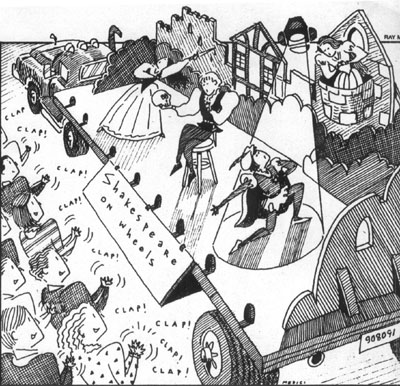By Louise Sweeney
Staff writer of The Christian Science Monitor
In the past year, "Shakespeare on Wheels" has rolled
the Bard's great plays on flatbed trucks into the
lives of more than 12,000 ordinary people.
But the seed of the idea was planted over 23 years ago
in the west African country of Nigeria.
The producer and father of "Wheels" is William T. Brown,
chairman of the theater department of the University of
Maryland in Baltimore County. Dr. Brown says the idea first
came to him when he was on a Rockefeller Foundation
grant to establish a school of drama at the University
of Ibadan in Nigeria.
That year was the 400th anniversary of the birth of
Shakespeare. Both Brown and the British professor to whom
he was a technical consultant wanted to celebrate the
event with a Shakespearean production.
Brown had noticed that "many of the African students
during their Easter vacation would get together in a
station wagon or lorry and travel around to some of the
neighboring communities to put on some kind of dramatic
presentation."
'I began to think of how I could literally put an
Elizabethan or Shakespearean stage on a movable unit,
and came up with the idea of a flatbed truck.'
-Dr. William T. Brown
The professor said, "Wouldn't it be nice if we could
really bring theater to the people?"
Then he remembered how during the medieval period in
theater they had pageants that moved groups of
players from one community to another.
"So I began to think of how I could literally put an
Elizabethan or Shakespearean stage on a movable unit,
and came up with the idea of a flatbed truck," he
recalls. "We could erect on the truck a collapsible unit
that could travel as a tractor-trailer. When we reached
our destination, we could unfold the unit on stage.
"I designed a replica of the Globe Theater in such a way
that it's like one of those pop-up fairy tale books. It
suddenly opens up, and out pops the Elizabethan stage.
That first "Shakespeare on Wheels" - the one in Africa -
included a series of Shakespearean excerpts from his
tragedies, comedies, and histories.
"We toured the Nigerian countryside, 4,000 to 5,000
miles in a four-week period, a very grueling tour," says
Brown. "But it was so gratifying because we appeared before
audiences of four- or five-thousand people at one time, all
standing.
"Many were from missionary schools and would travel up to
75 miles or more to see the production. It was just a
shilling to see. They enjoyed it, and the response was
unbelievable."
He remembers that the first evening they performed in Nigeria,
one of the actors began to do Hamlet's famous soliloquy
beginning, "To be or not to be...."
"And we began to hear an echo," Brown says, "and were
mystified, because this was an open area, with nothing
for the sound to bounce off of. When we looked closely, we found that the sound was coming from the mouths of the audience, reciting the soliloquy along with the performer."
They had learned many of the soliloquies in their missionary schools. Brown was "just amazed." In years of teaching, he says, he has found few American students who would do that.
Three years ago, the University of Maryland in Baltimore County had a director of its summer session who was looking for a new program. Brown, who for over 20 years had cherished the idea of re-creating "Shakespeare on Wheels" inthe United States, suggested it.
When the director found the money for it,the program began with "A Midsummer Night's Dream" rolling through Neighboring counties and the city of Baltimore. The second year it was "Romeo and Juliet" on an extended tour in Maryland.
This past year, the tour has expanded to 35 performances, including Mayland's Eastern Shore, as well as nearby out-of-state gigs in Washington, D.C., at Dickinson College in Carlisle, Pa., and in Arlington, VA. The shows are free to the public, but a fee is charged to sponsoring sites to cover costs.
The troupe of 15 to 20 cast and crew members is drawn from the university's theater students, who are enrolled in a course that earns them three credits toward their degrees.
During the medieval period in theater they had pageants that moved groups from one community to another.
Since most of the work is at night, they can hold day jobs that allow them to earn the money for college expenses.
Their tuition for the truck-stop Shakespeare course is paid from a scholarship fund Brown set up, using box office receipts from productions staged during the regular college year.
The budget of $35,000 to $40,000 includes the salary for director Sam McCready, as well as the costume designer and technicians. a $4,000 grant from the Maryland State Arts Council, part of the National Endowment for the Arts, has helped the budget, as has the $500 sent in by fans of the shows.
"To expand and keep going," Brown says, "the budget needs to be increased." He's looking for more grants and possible a corporate sponsor.
"It's wonderful for me to see the reception over the past three years. I think it has a great potential to become possibly a national thing," Brown continues.
Meanwhile, he's hovering over a choice of the play for next year. Should it be "Two Gentlement of Verona," "The Tempest," or "A Comedy of Errors"?
The answer: As you like it, Dr. Brown
| 
